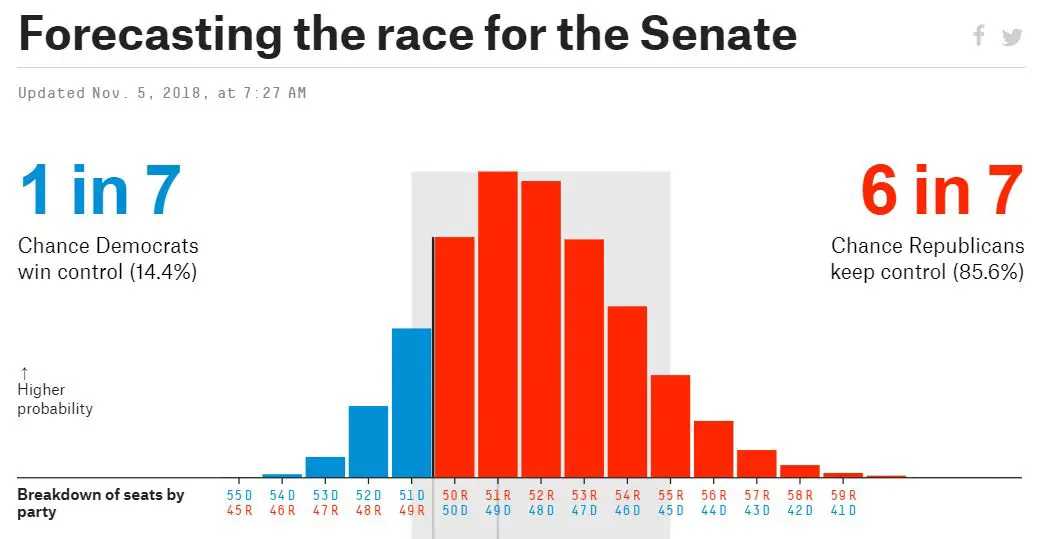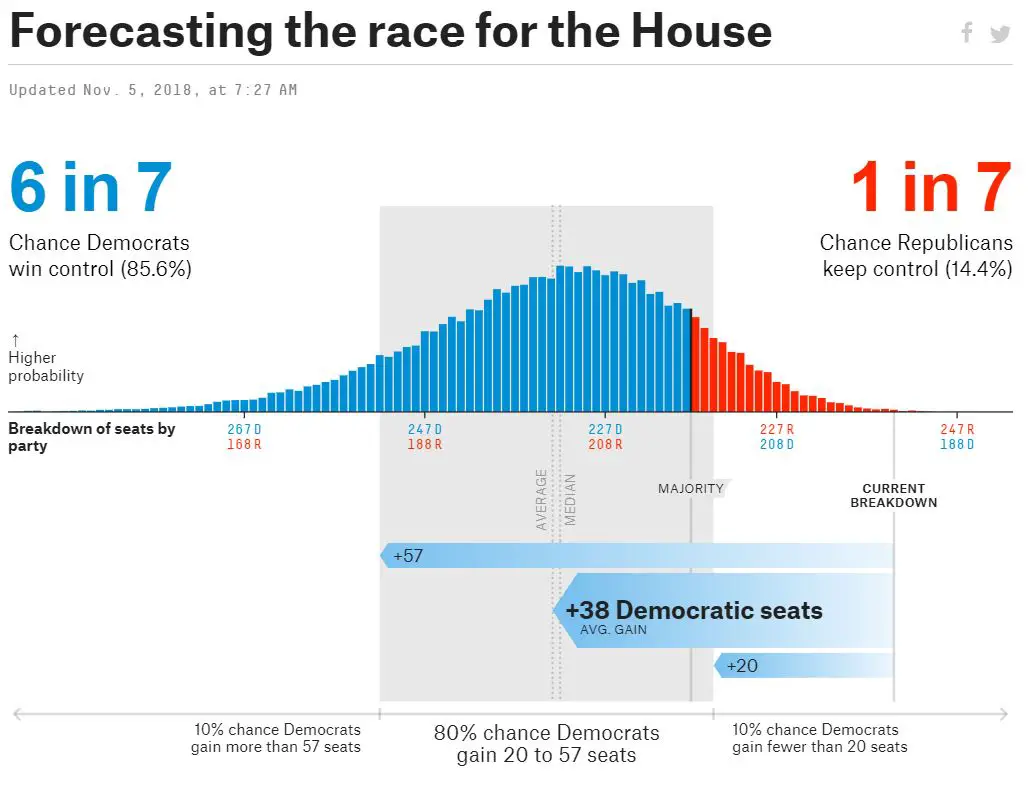Well, here we are. Countdown to 1 day until Election Day 2018 and the verdict rendered by voters in the midterms will soon be known across the country. The predictions vary from race to race, and from pollster to pollster, but the general thinking is that Democrats are poised to take control of the House, while Republicans may expand their majority in the Senate. Here is a rundown of various models and predictions from across the political spectrum on the 2018 midterms.
Cook Political Report
The non-partisan Cook Political Report recently upped their estimate for Democratic control of the House, pegging the number at somewhere around 30 to 40 seats. Democrats only need 23 seats to change hands to take control. The new numbers are an improvement for Democrats versus the prior estimate of 25 to 35 seats. Cook justifies this new estimate by pointing out races which have just recently become competitive in areas which were previously being viewed as “Likely” Republican districts. Here’s the latest update from Dave Wasserman, House Political Directory for Cook:
NEW at @CookPolitical: 10 final House rating changes. Biggest moves are towards Dems:#FL25: Diaz-Balart (R) – Likely R to Lean R#GA06: Handel (R) – Lean R to Toss Up#MI06: Upton (R) – Likely R to Lean R#PA10: Perry (R) – Lean R to Toss Up#WA08: OPEN (R) – Toss Up to Lean D
— Dave Wasserman (@Redistrict) November 5, 2018
Read more on the Cook Political ratings from the Washington Examiner.
RealClearPolitics (RCP)
RCP is known, of course, for being the “poll of polls” in that they aggregate public poll results for various races and then average the results together to get an overall feel for a race which tries to account for outliers. It’s a very simple model but has proven to be fairly accurate since it relies on many data points. In the 2018 midterms, as of press time, the RCP model sees a Democratic pickup of anywhere from the low end of 7 seats, up to the high end of 46 seats. That range is huge and indicates anything from the GOP retaining House control to a complete and utter blowout by Democrats amassing a huge House majority.
In the Senate, the RCP model gives Republicans a net pickup of 1 Senate seat which assumes that the GOP flips North Dakota and Missouri, but loses Arizona to Democrats. This would give Republicans a 52 to 48 majority.
FiveThirtyEight
FiveThirtyEight is giving Democrats an 85% chance of taking the House, and Republicans an 85% chance of holding the Senate. Most analysts see this, based on the data, as the likely outcome, though if we learned anything from reading the tea leaves in 2016, the data can sometimes be wrong.
Still a Toss Up
Finally, to throw you a final curveball, NBC News is reporting that with record high turnout numbers for a midterm, the prediction models are being put to the test, and nobody really knows what the outcome will be.
There are so many races listed as “toss-up” and neither party seems to have locked this election down yet. The one thing most analysists do agree on is that Democrats would be very hard-pressed to win control of the Senate. Republicans are much more likely to expand their Senate majority since they are on the offense in several states held by Democratic Senators where Trump won big in 2016.
On the House side, with the historical trends pointing to Democrats, you’d think this would be easy to predict, and maybe on Wednesday morning we’ll look back to today and wonder why we were even questioning how well Democrats were going to do. Perhaps pollsters are underestimating the chances for Democrats out of fear over the 2016 election where Republicans were underestimated in several key states. Perhaps pollsters are being cautious, not wanting to use any data models that give either side an overt advantage since they’re just not sure which part of the electorate will show up on Tuesday given the massive interest and high enthusiasm on both sides.
To offer an even further contrarian view, what of pollsters are severely underestimating Republicans this time around, as they did in 2016? Perhaps the “silent majority” of Trump voters will show up in 2018 in districts and areas where pollsters weren’t expecting it, thus pushing more electoral chaos into models which rely on historical data and predictable behaviors.
I think my bases are covered in saying nobody really knows, and the good news is that we will be getting our first results less than 36 hours from now.
Donate Now to Support Election Central
- Help defend independent journalism
- Directly support this website and our efforts


